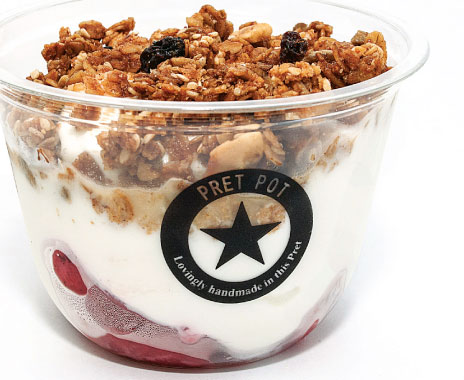For a food that’s only been available in the U.S. on a significant commercial scale since World War II, yogurt has certainly embedded itself into our national culinary consciousness in a hurry. The vast variety of brands, flavors, styles, consistencies, and packaging formats now available at your local grocery store is a testament both to yogurt’s increasing mass appeal and its unusual versatility and flexibility.
Just try to come up with another single ingredient that fulfills so many of the criteria consumers look for in their diets and on their taste buds today: it’s high in protein; capable of being consumed with a spoon or straw; available in both sweet and savory forms; useful for cooking and baking; loaded with probiotics and other functional ingredients; indulgent; suitable for breakfast, lunch, and dinner; and, in most forms, relatively low in fat and calories.
That’s yogurt, and that’s why its popularity in retail environments has soared in the past decade or two. The U.S. Department of Agriculture’s National Agricultural Statistics Service reported earlier this year that annual yogurt sales had more than doubled since 2001. Greek yogurt, meanwhile, is one of the runaway food success stories of the past decade, having reportedly grown from 1 percent of the yogurt market in 2007 to more than a third today.
These factors also help explain why I’m confident that quick-serve concepts could be doing more with the stuff. At the Culinary Institute of America’s 2013 World of Flavor conference, it was pointed out that while yogurt is a standard pantry ingredient in much of the rest of the world, chefs here in the U.S. are still only beginning to tap its potential. So while the number and range of applications featuring yogurt are already impressive—from parfaits to frozen desserts to smoothies—the options extend far further. Consider what you can do with yogurt:
You can smoke it. Smoking yogurt with a smoking gun or chamber, or infusing into it a smoky taste using various spices and flavorings, creates a savory flavor profile that, combined with the product’s inherent tartness and creaminess, enlivens everything from pizza to burgers to dipping sauces. It also makes a great all-purpose salad dressing or spread for any number of sandwiches, burritos, wraps, or other standard fast-food items. And yogurt’s healthful qualities typically ensure that the result is less decadent than alternatives featuring mayonnaise.
In a similar vein, menu developers can look to the Blue Hill brand for a sense of how creative one can get with yogurt. The company’s unorthodox concoctions, mixed with pure vegetable purées, include carrot, sweet potato, beet, butternut squash, parsnip, and tomato, and all offer potential use in sauces, condiments, and purées that pack a nutritious punch.
It’s ideal for extreme quaffables. Using yogurt as a key ingredient in refreshing fruit or tea beverages—from Indian lassi to Mexican licuados—is nothing new. But given Millennials’ fascination with extreme flavor profiles, it may be time for some free-spirited concept to experiment with more outré yogurt-based beverages. Introducing hot chilies to fruit-based drinks, for instance, wouldn’t be too far afield for the under-30 set and could form the basis for a truly novel line of extreme quaffables.
It works well in snack foods and baked goods. At the World of Flavor event, I had the opportunity to sample a Turkish cracker made with tarhana, a mixture of wheat berries and vegetables that is fermented with yogurt before being dried and used in a variety of contexts, including soups and baked goods. In this case, the cracker was crisp, and it retained the tanginess of yogurt, which made for an intriguing taste and mouthfeel.
But snack foods could be just the beginning. Incorporating yogurt into hamburger buns, rolls, pastries, or pizza crusts could significantly enhance the allure of any number of standard baked goods. And when it comes to batter, there’s no reason why yogurt can’t replace buttermilk in coatings intended for deep frying. Yogurt-fried chicken could be a game-changer.
Its frozen form has further to go. Frozen yogurt gets plenty of love these days, but compared with ice cream, which in recent years has spawned a staggering array of varieties, fro yo has a lot further to go. Chains like Yogurtland and Pinkberry have tapped into consumers’ desire for difference with flavors ranging from pomegranate, pistachio, and peppermint stick to cake batter, peanut butter, taro, and mango, but it doesn’t take a whole lot of imagination to envision a future where these offerings represent just the tip of the iceberg.
The takeaway here is that yogurt holds plenty of untapped possibilities for quick-serve concepts that want to ratchet up the healthful attributes of a wide range of menu items, while also imparting richness, creaminess, and a sense of indulgence. I’ll be interested to hear what kinds of creative tacks menu developers take. Feel free to let me know what you come up with by dropping a line to Marc@QSRmagazine.com.













